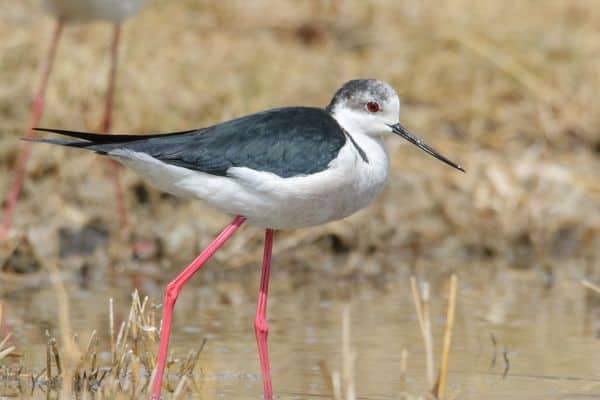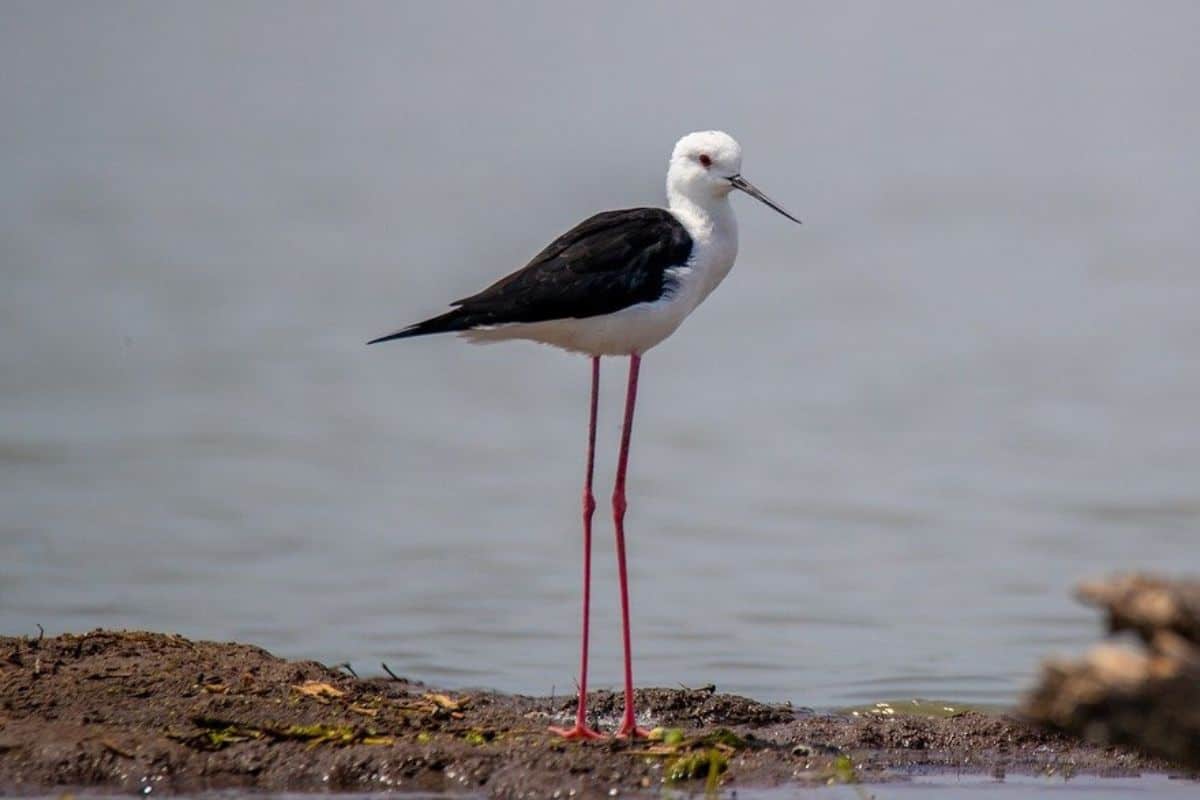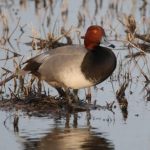Common Name: Black-winged Stilt
Scientific Name: Himantopus himantopus| Size | Diet | Range in Hawaii | Status in Hawaii |
|---|---|---|---|
| 13 in. - 15 in. | insects, crustaceans, and mollusks | Oahu | Least Concern |
The Black-winged Stilt (Himantopus himantopus) is a striking and elegant bird species that is widely distributed throughout much of the world. These long-legged wading birds are known for their distinctive black and white plumage and bright pink legs, making them a favorite among bird enthusiasts and nature lovers alike. While the Black-winged Stilt is not native to Hawaii, it is a migratory species that can be seen in the state during the winter months.
In this article, we will delve into the fascinating world of the Black-winged Stilt, exploring its biology, behavior, and habitat. We will also take a closer look at the Black-winged Stilt’s presence in Hawaii, including where and when these birds can be spotted in the state.
Black-winged Stilt
Appearance

The Black-winged Stilt is a striking bird known for its elegant appearance. With long, slender legs and a graceful neck, it stands tall at an impressive height of 13 to 15 inches (33 to 38 centimeters). Its body is predominantly white, contrasting beautifully with its long, thin black wings. This stilt species boasts a distinct black head and neck, adding to its distinctive and eye-catching allure.
Diet
The Black-winged Stilt has a diverse and adaptable diet. As a wading bird, it primarily feeds on aquatic invertebrates such as insects, crustaceans, and mollusks.
It uses its long, slender bill to probe the mud or shallow waters in search of prey. Additionally, it also consumes small fish, tadpoles, and aquatic vegetation. This versatile diet allows the Black-winged Stilt to thrive in various wetland habitats across its range.
Nesting
The Black-winged Stilt engages in unique nesting behaviors. They typically construct their nests on the ground, often near water bodies or in marshy areas. The nests are shallow depressions lined with grasses, twigs, and other vegetation.
Males and females collaborate in building the nest, with the male gathering materials and the female arranging them. The female usually lays a clutch of three to five eggs, which are pale and speckled. Both parents take turns incubating the eggs for about three to four weeks until they hatch.
Once the chicks emerge, they are precocial, meaning they are able to leave the nest and start feeding themselves shortly after hatching. The parents diligently care for and protect the chicks until they become independent and capable of flying, which typically takes several weeks.
Behavior

The Black-winged Stilt exhibits fascinating behaviors that make it a captivating bird to observe. These birds are highly social and often form large flocks, especially during the non-breeding season.
They are known for their graceful and elegant movements, characterized by their long legs and necks. Black-winged Stilts are agile waders, adept at foraging in shallow waters where they use their long, thin bills to probe the mud or sweep through the water to catch prey.
During the breeding season, Black-winged Stilts engage in impressive courtship displays. Males perform elaborate rituals to attract females, including wing-flapping, high-stepping walks, and calling. Once pairs form, they engage in synchronized displays and intricate dances, reinforcing their bond.
These birds are also highly territorial, fiercely defending their nesting sites from intruders, including other stilts. They use various displays, such as aggressive postures and calls, to deter potential threats.
In flight, Black-winged Stilts showcase their striking black and white wing patterns, with their long wings allowing them to glide effortlessly and soar above wetlands.
Habitat
The Black-winged Stilt is a bird that thrives in a variety of wetland habitats. It can be found in both freshwater and saltwater environments, including marshes, lagoons, estuaries, coastal wetlands, and shallow lakes. These stilts have a preference for areas with shallow water and ample mudflats, which provide abundant food sources.
Their habitat choice often includes areas with emergent vegetation, such as reeds and grasses, which offer cover and nesting sites. These birds are well adapted to wading, using their long legs to navigate through marshy areas and forage in shallow waters.
Black-winged Stilts are known to inhabit both tropical and temperate regions across the globe, making them highly adaptable to various climatic conditions.
Range
While the Black-winged Stilt is not native to Hawaii and does not have an established range in the state, there have been occasional sightings of this bird species in Hawaii, including on the island of Oahu. These sightings are likely to be rare occurrences of vagrant individuals.
Conservation Status

The Black-winged Stilt currently holds a conservation status of “Least Concern” according to the International Union for Conservation of Nature (IUCN). This designation indicates that the species is not facing significant threats that could lead to its extinction in the near future.
The Black-winged Stilt benefits from its adaptable nature and wide distribution, which spans across multiple continents. It has the ability to occupy various wetland habitats, including both natural and man-made environments, which provides some resilience against localized habitat loss or degradation.
Interesting Facts
1. Aggressive defenders
When it comes to protecting their nests and territories, Black-winged Stilts are fiercely defensive. They display aggressive postures and vocalizations to deter potential threats.
2. Precocial chicks
Black-winged Stilt chicks are precocial, meaning they are capable of leaving the nest and feeding themselves shortly after hatching. However, they still rely on parental care and protection until they are fully independent.
3. Social birds
Black-winged Stilts are highly social and often form large flocks, particularly during the non-breeding season. They engage in various social behaviors, including synchronized displays and intricate courtship dances.
4. Versatile foragers
Black-winged Stilts have a diverse diet, feeding on aquatic invertebrates, small fish, tadpoles, and even aquatic vegetation. Their long, thin bills enable them to efficiently capture prey.
5. Impressive height
Standing at a height of 13 to 15 inches (33 to 38 centimeters), the Black-winged Stilt is a tall and slender bird.
6. Elegant appearance
The Black-winged Stilt is known for its striking and elegant appearance, with its long legs and neck, black and white plumage, and distinctive red eyes.
Frequently Asked Questions
1. What is the average lifespan of a Black-winged Stilt?
Black-winged Stilts have an average lifespan of around 8 to 10 years in the wild.
2. Are Black-winged Stilts good swimmers?
While Black-winged Stilts are adept waders and can navigate shallow waters with ease, they are not strong swimmers. They rely more on their long legs for foraging in wetland habitats.
3. Are Black-winged Stilts aggressive towards humans?
Black-winged Stilts are generally not aggressive towards humans unless they feel their nests or young are being threatened. They may display defensive behaviors and vocalizations to protect their territories.
4. Can Black-winged Stilts fly long distances?
Black-winged Stilts are capable of flying long distances, especially during migration. Their long, slender wings allow them to cover considerable distances while migrating between breeding and wintering grounds.
5. Do Black-winged Stilts make any distinct sounds?
Yes, Black-winged Stilts have a variety of vocalizations, including sharp, high-pitched calls and alarm calls when disturbed. During courtship displays, they may also engage in soft, melodic calls.




